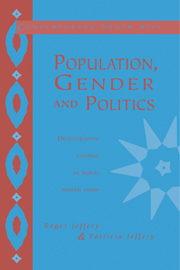Crossref Citations
This Book has been
cited by the following publications. This list is generated based on data provided by Crossref.
Corbridge, S
1997.
Guest Editorial.
Environment and Planning A: Economy and Space,
Vol. 29,
Issue. 12,
p.
2091.
Corbridge, Stuart
1999.
‘The militarization of all Hindudom’? The Bharatiya Janata Party, The bomb, and the political spaces of Hindu nationalism.
Economy and Society,
Vol. 28,
Issue. 2,
p.
222.
Säävälä, Minna
1999.
Understanding the Prevalence of Female Sterilization in Rural South India.
Studies in Family Planning,
Vol. 30,
Issue. 4,
p.
288.
Mason, Karen Oppenheim
and
Smith, Herbert L.
2000.
Husbands’ versus wives’ fertility goals and use of contraception: The influence of gender context in five Asian countries.
Demography,
Vol. 37,
Issue. 3,
p.
299.
Drèze, Jean
and
Murthi, Mamta
2001.
Fertility, Education, and Development: Evidence from India.
Population and Development Review,
Vol. 27,
Issue. 1,
p.
33.
Underhill‐Sem, Yvonne
2001.
Maternities in ‘out‐of‐the‐way’ places: epistemological possibilities for retheorising population geography.
International Journal of Population Geography,
Vol. 7,
Issue. 6,
p.
447.
Jeffery, Roger
Jeffrey, Craig J.
and
Jeffery, Patricia M.
2001.
Social and political dominance in western UP : A response to Sudha Pai.
Contributions to Indian Sociology,
Vol. 35,
Issue. 2,
p.
213.
Guilmoto, Christophe Z.
and
Rajan, S. Irudaya
2001.
Spatial Patterns of Fertility Transition in Indian Districts.
Population and Development Review,
Vol. 27,
Issue. 4,
p.
713.
Jeffrey, Craig
2002.
Caste, Class, and Clientelism: A Political Economy of Everyday Corruption in Rural North India*.
Economic Geography,
Vol. 78,
Issue. 1,
p.
21.
Morgan, S. Philip
Stash, Sharon
Smith, Herbert L.
and
Mason, Karen Oppenheim
2002.
Muslim and Non‐Muslim Differences in Female Autonomy and Fertility: Evidence from Four Asian Countries.
Population and Development Review,
Vol. 28,
Issue. 3,
p.
515.
Kielmann, Karina
2002.
Theorizing health in the context of transition: The dynamics of perceived morbidity among women in Peri-Urban Maharashtra, India.
Medical Anthropology,
Vol. 21,
Issue. 2,
p.
157.
Murphy, Rachel
2003.
Fertility and Distorted Sex Ratios in a Rural Chinese County: Culture, State, and Policy.
Population and Development Review,
Vol. 29,
Issue. 4,
p.
595.
Borooah, Vani K.
2003.
Births, Infants and Children: An Econometric Portrait of Women and Children in India.
Development and Change,
Vol. 34,
Issue. 1,
p.
67.
Kielmann, Karina
and
Bentley, Margaret
2003.
Thresholds of Morbidity among Women in a Peri-Urban Community of Maharashtra, India: Conceptual and Methodological Issues.
Journal of Health Psychology,
Vol. 8,
Issue. 5,
p.
525.
Unnithan-Kumar, Maya
2003.
Spirits of the womb: Migration, reproductive choice and healing in Rajasthan.
Contributions to Indian Sociology,
Vol. 37,
Issue. 1-2,
p.
163.
Jeffrey, Craig
Jeffery, Roger
and
Jeffery, Patricia
2004.
Degrees without Freedom: The Impact of Formal Education on Dalit Young Men in North India.
Development and Change,
Vol. 35,
Issue. 5,
p.
963.
Jeffrey, Craig
Jeffery, Patricia
and
Jeffery, Roger
2004.
“A Useless Thing!” or “Nectar of the Gods?” The Cultural Production of Education and Young Men's Struggles for Respect in Liberalizing North India.
Annals of the Association of American Geographers,
Vol. 94,
Issue. 4,
p.
961.
Bates, Karine
2004.
The Hindu Succession act: One Law, Plural Identities.
The Journal of Legal Pluralism and Unofficial Law,
Vol. 36,
Issue. 50,
p.
119.
Dharmalingam, A.
and
Morgan, S. Philip
2004.
Pervasive Muslim-Hindu fertility differences in India.
Demography,
Vol. 41,
Issue. 3,
p.
529.
Corbridge, Stuart
Williams, Glyn
Srivastava, Manoj
and
Véron, René
2005.
Seeing the State.



